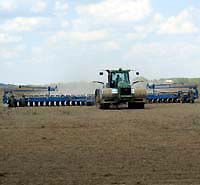Spring Planting on Fast Track
Spring Planting on Fast Track

Kentucky’s grain farmers are moving through their fields at a fast pace, thanks to favorable weather conditions in recent weeks. This will allow many of them to have their corn planted in a timely manner, which increases their chances for optimum yields.
It is important to get an early start on planting corn to reach the maximum yield potential and to be finished prior to when yields generally begin to decline, said Jim Herbek, grain crops specialist with the University of Kentucky College of Agriculture. It is also important not to start too early because cool soil temperatures can delay emergence and stress the plants. No-till fields will warm more slowly than bare soil, something that farmers also must consider when planting.
Results of a six-year study conducted by Herbek and other UK specialists determined that Kentucky farmers have an optimum window for planting that varies somewhat as you move across the state.
Over the long term, planting between April 10 and April 30 should achieve the best results. To avoid substantial yield losses farmers in far west Kentucky should be finished by May 1, in west-central Kentucky by May 5 to May 10, and in eastern Kentucky by May 10 to May 15.
“Planting date research tells us what will most likely occur, and not what will actually occur in a single year,” Herbek said. “Because of yearly weather fluctuations, the optimum planting date may vary somewhat for any specific year, but over the long term the ‘normal’ planting date period provides the best probability of obtaining maximum corn yield potential.”
This year, much of the state’s growers look likely to meet those timeframes. The latest planting estimates by the Kentucky field office of the National Agricultural Statistics Service show 70 percent of the state’s corn is planted. In addition to good weather, another factor that may come into play on timely planting this year is the reduction in total acres expected to be planted in corn.
On the state level, expectations are that farmers will plant 180,000 fewer acres this year than in 2005 while planting intentions show 170,000 additional acres to be planted in soybeans. Nationally, if intentions become reality this would be the smallest corn crop planted since 2001 and the largest recorded soybean crop.
While planting date plays an important role in yield potential, Herbek said, the crop’s final outcome will be determined by management practices such as pest control and fertility as well as weather conditions throughout the growing season.
